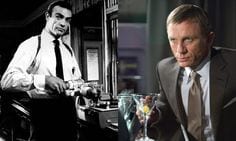Licence to swill: James Bond’s drinking over six decades
Abstract
Objectives
To describe the patterns of alcohol use in James Bond movies over six decades.
Design
Film content analysis.
Setting
Wide range of international locations in 24 James Bond movies (Eon Productions series, 1962–2015).
Main outcome measures
Alcohol consumption episodes for Bond and major female characters; alcohol product placement in films; peak estimated blood alcohol concentrations; features relevant to DSM-5 criteria for alcohol use disorder.
Results
Bond has consumed alcohol heavily and consistently across six decades (109 alcohol consumption events; mean, 4.5 events per movie). His peak blood alcohol level was estimated to have been 0.36 g/dL, sufficient to kill some people.
The researchers classified Bond as having severe alcohol use disorder, as he satisfied six of 11 DSM-5 criteria for this condition. Chronic risks for Bond include frequently using alcohol prior to fights, driving vehicles (including in chases), high stakes gambling, operating complex machinery or devices, contact with dangerous animals, extreme athletic performance, and sex with enemies, sometimes with guns or knives in the bed.
Notable trends during the study period included a decline in using alcohol as a weapon (P = 0.023) and an increase in the number of alcohol products in his environment (for alcohol-related product placement: P < 0.001), but his martini consumption has been steady.
Alcohol use by lead female characters and a random selection of 30 of his sexual partners was fairly stable over time, but also occasionally involved binges.
Conclusions
James Bond has a severe chronic alcohol problem.
He should consider seeking professional help and find other strategies for managing on-the-job stress.
Analysis
The known
James Bond exhibited problematic alcohol consumption in the Bond books, but their content often deviates from that of the movies.
The new
Bond showed a consistent pattern of heavy alcohol intake in all 24 movies over six decades (109 alcohol consumption events). His peak binge involved 24 units of alcohol (6 vespers), enough to kill some people. His hazardous activities after alcohol copnsumption included fights, vehicle chases, contact with dangerous animals, and sex with enemies, sometimes with guns or knives in the bed.
The implications
Analyzing 007’s relation to booze is a useful exercise to investigate how the entertainment and alcohol industries work over decades to fuel an alcohol norm, where alcohol harm has been glamorized.
